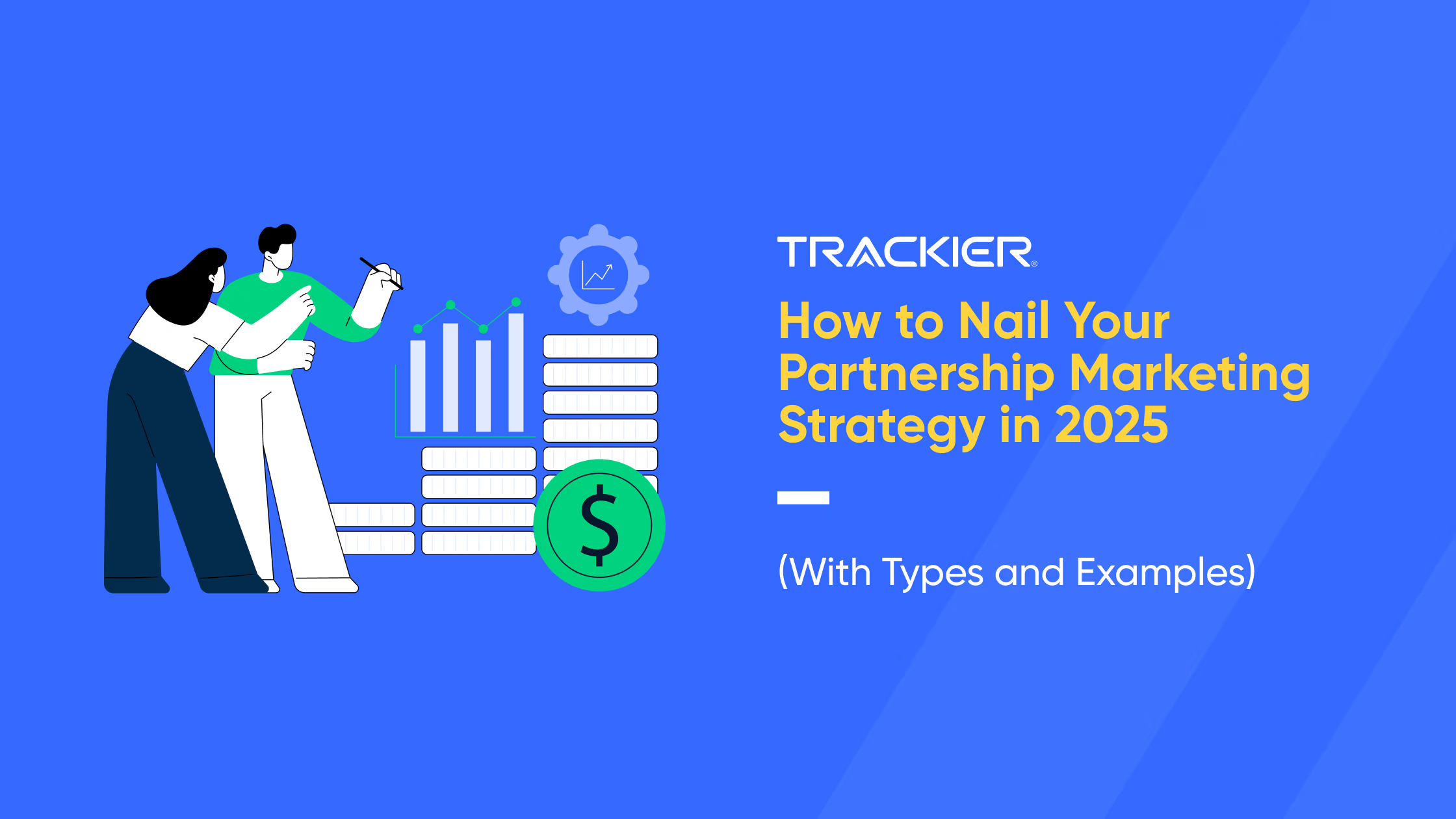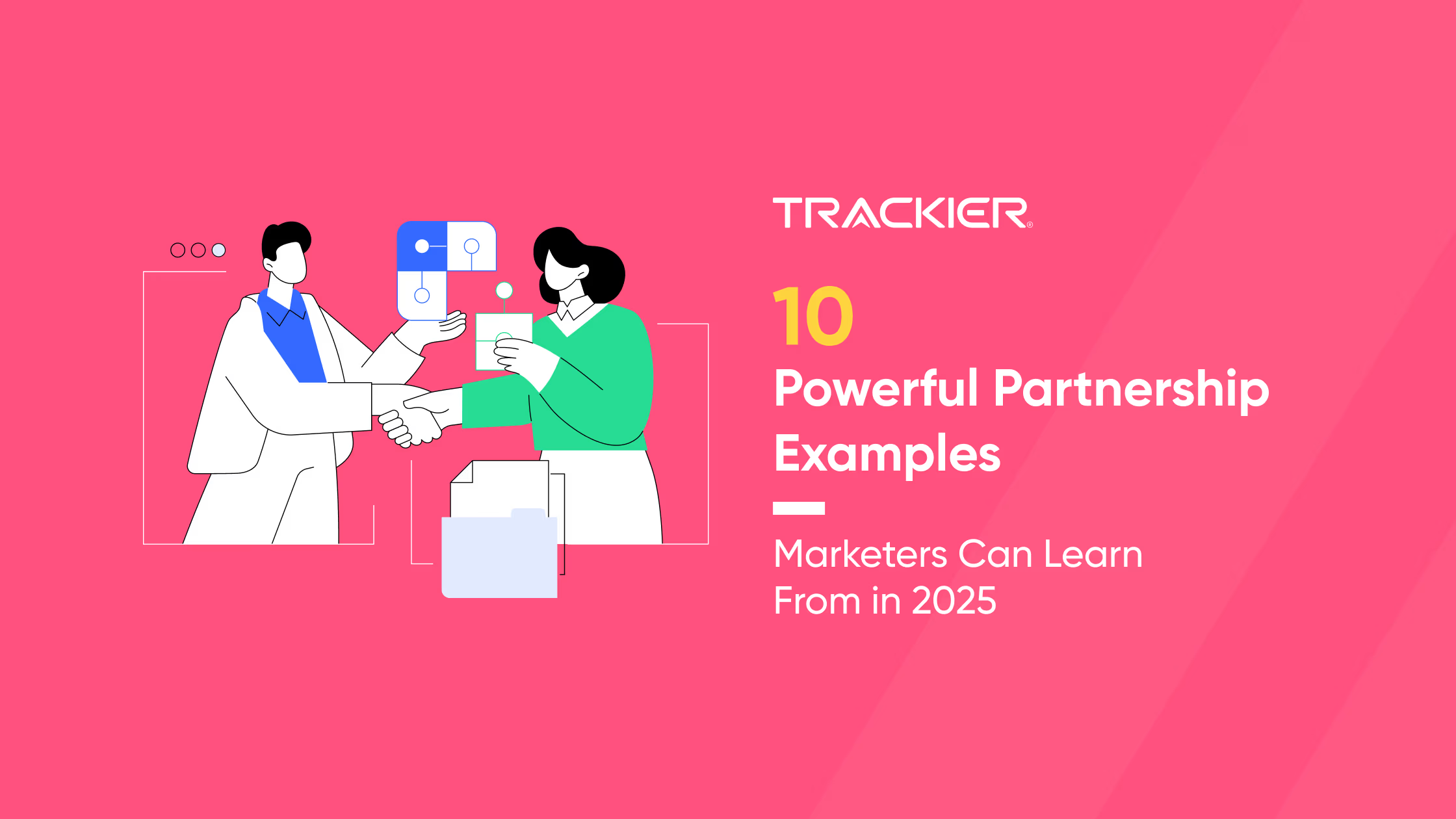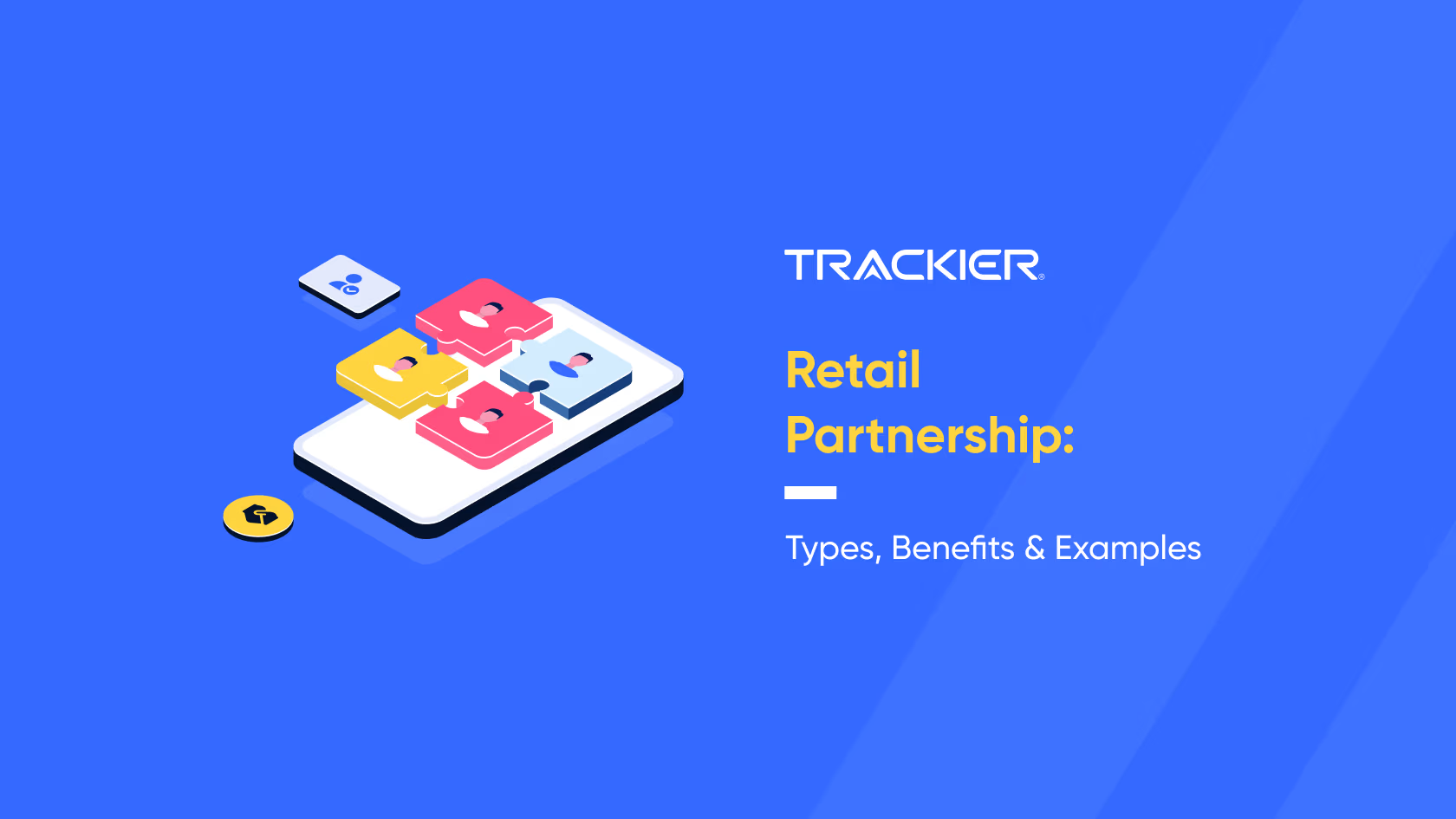Marketing solo is starting to feel like a losing game, isn’t it?
Channels are crowded, CPCs are spiraling, and even your most polished ad creatives are getting lost in the scroll. At some point, it becomes clear, reach alone isn’t enough. You need leverage.
And that’s where partnership marketing strategy enters the picture.
Simply put, a partnership marketing strategy is when two brands team up to share audiences, build credibility faster, and drive measurable growth.
But wait, it’s not all guest posts or shoutouts. There are various different types of marketing partnerships, but they all aim at creating campaigns that deliver value for both sides and results for both audiences.
You’ve seen it. A co-branded campaign that suddenly makes sense. Two tools that integrate, promote each other, and feel like they were always meant to work together. Or a startup, quietly riding on the brand equity of a bigger player.
In this blog, we’ll walk through:
- The different types of partnership marketing strategy you can explore
- How to build a smart, scalable partner marketing strategy
- Real examples that work
- And how to make the whole thing measurable using a platform like Trackier
Need help managing marketing partnerships? Explore Trackier’s partner marketing software to see how we simplify the stack.
Why Do So Many Marketers Turn to Partnership Marketing Strategy Now?
Because a well crafted partnership marketing strategy works. And more importantly, because it works better in a landscape that’s become unpredictable, expensive, and increasingly ad-resistant.
Marketing teams today are grappling with rising acquisition costs, shrinking attention spans, and algorithms that change faster than the quarterly roadmap. Add to that the fatigue from paid media saturation, and it’s no surprise that marketers are leaning into something more sustainable.
Partnership marketing strategy offers a smarter way to scale. Instead of pushing messages out to cold audiences, you’re being introduced through someone your audience already trusts. It’s not just distribution, it’s validation.
In fact, according to a 2025 Adobe survey, brands using structured marketing partnerships saw a 28% higher ROI over paid channels within the first six months of launching their partner programs.
It’s not just the ROI, though. Partnerships are proving more agile. More trackable. And frankly, more human. Especially in B2B and SaaS ecosystems, where relationships still move the needle, partner marketing gives you both credibility and coverage without the media spend bloat.
And unlike a one-size-fits-all campaign, partnership marketing strategy allows you to build on strengths you already have, whether that’s content, reach, tech, or trust.
So the question isn’t whether to try it. It’s how to make it work for your brand.
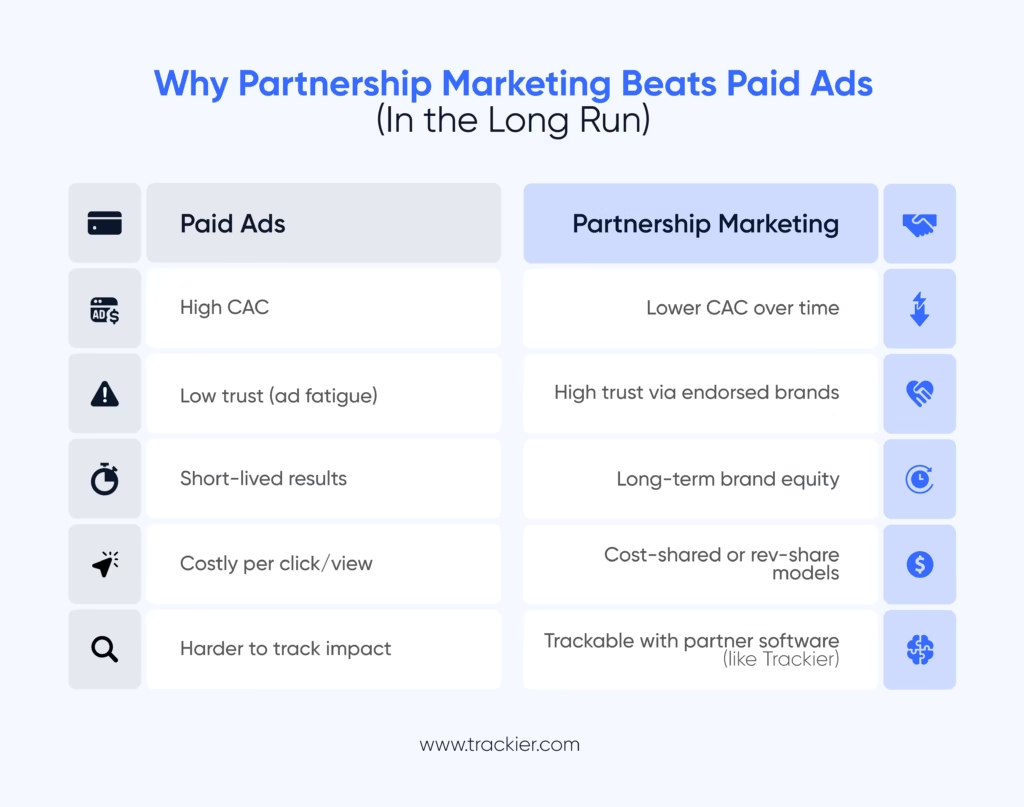
How Does a Partnership Marketing Strategy Actually Work Behind the Scenes?
A partnership marketing strategy isn’t a one-off campaign or a handshake deal with a logo swap. It’s a layered collaboration where two or more brands bring their assets to the table, whether that’s audience reach, content channels, distribution networks, or even product integrations, and work toward shared goals.
At the heart of most partner marketing campaigns is a simple idea:
“Your audience trusts you. My audience trusts me. Let’s introduce them to something valuable, together.“
Here’s what typically happens behind the scenes:
1. Audience Mapping
Each brand outlines its audience segments to identify overlap. If you’re a SaaS brand partnering with a newsletter platform, for example, your users may already be looking for better email solutions. That overlap becomes the starting point.
2. Shared Promotions
These can take many forms, such as joint webinars, bundled offers, content swaps, newsletter shoutouts, or referral links. You might co-create an ebook, or run a limited-time campaign that both parties promote across their owned channels.
3. Tracking and Attribution
Here’s where it gets serious. Behind every partnership marketing strategy or campaign that scales, there’s tracking infrastructure in place.
Using tools like Trackier, both partners can track performance, who brought in the lead, how they converted, what they’re worth long-term.
This goes far beyond affiliate links. With the right setup, partners can share UTM parameters, split performance dashboards, and automate attribution and payouts without friction.
4. Collaborative Value
The real win is not just traffic or clicks. It’s access. You’re getting into conversations, inboxes, and feeds where you wouldn’t normally be. That kind of entry point, when done right, converts faster and sticks longer.
So when people ask what is partnership marketing strategy, it’s about creating net-new opportunities by combining trust, audience, and aligned intent.
What Are the Different Types of Marketing Partnerships That You Can Use?
When marketers talk about marketing partnerships, they’re rarely referring to a one-size-fits-all approach. It is a myriad of strategies from which you pick the model based on your goals, your audience, and the level of collaboration you’re ready for.
Let’s break down the most effective types of marketing partnerships, with use cases:
1. Affiliate Partnerships
Affiliate partnerships are built for performance. In this model, you collaborate with affiliates, these can be publishers, influencers, content creators, or dedicated affiliate websites, who promote your product or service using custom referral links. They get paid a commission only when they drive a defined action, such as a sale or a sign-up.
This is a low-risk, high-reward setup because you only pay for results. It’s trackable, scalable, and especially effective for eCommerce, SaaS, and subscription businesses where conversions are easy to measure.
In 2024, affiliate marketing delivered an average ROI of $5.78 for every dollar spent.
Example: Think of cashback or coupon sites that promote your deal, or a niche newsletter that reviews your tool with a referral link.
Best for: Brands focused on performance, ROI, and cost-effective reach.
2. Co-Branding Campaigns
Co-branding is about brand synergy. Two brands come together to create a unified campaign, asset, or product that highlights the strengths of both. This could be a co-branded ebook, a themed product line, or a digital ad campaign that runs across both brand’s channels.
The secret here is trust transference. When done well, your partner’s brand equity rubs off on yours, and vice versa. It works especially well when the two brands serve similar audiences but don’t compete directly.
In 2024, 84% of top-tier B2B companies relied on co-marketing to outperform peers.
Example: The collaboration between Spotify and Starbucks allowed Spotify to enter physical stores, while Starbucks strengthened its cultural cachet among music lovers.
Best for: Brand awareness, audience cross-pollination, and building social proof fast.
3. Technology Integrations
This model is especially relevant in SaaS and tech ecosystems. You integrate your product with a complementary tool (think CRM + marketing automation, or payments + analytics), then co-market that integration to both user bases.
The magic lies in how useful the combined solution is. You’re not only promoting each other, but also making your product more valuable.
Nearly 69% of consumers engage with brands across multiple touchpoints before purchasing an integrated solution helps own more of that journey.
Example: Slack and Zoom partnered to enable users to launch video calls directly from Slack, then promoted the integration through joint blogs, help docs, and product updates.
Best for: Driving product adoption, retention, and building ecosystem stickiness.
4. Content Collaborations
This is one of the most flexible partnership models out there. Content collaborations can take the form of joint blogs, podcasts, whitepapers, video series, webinars, or even shared research reports.
The idea is simple: your partner brings new ideas, reach, or subject matter expertise. You co-create something of value and promote it to both your audiences. It builds authority and strengthens organic visibility over time.
73% of B2B marketers say content marketing drives lead generation.
Example: A data platform partners with a customer success tool to release a report on churn metrics by industry, offering insights and driving leads for both.
Best for: SEO, lead generation, and thought leadership.
5. Channel Partners
Channel partnerships involve third-party vendors or resellers who sell your product as part of their offering. These partners usually have regional expertise, existing customer relationships, or complementary services.
In B2B, channel partners are crucial for entering new markets without building a sales team from scratch. It’s more structured and often includes training, enablement tools, and tiered incentives.
Example: A cybersecurity platform might partner with IT consultancies in different regions to resell their software along with managed services.
Best for: Global expansion and scaling go-to-market through indirect sales or businesses aiming for broader distribution without heavy upfront investment.
6. Sponsorships and Events
You can also partner by sponsoring your way into established events, platforms, or communities. Sponsorships may include podcasts, conferences, niche newsletters, or branded community initiatives.
This model gives you fast visibility and credibility, especially when aligned with a community your audience already trusts.
With ad fatigue hitting 50%, sponsored events offer efficient reach and credibility.
Example: A fintech SaaS brand sponsors a finance podcast and co-hosts a limited series on modern payment systems.
Best for: Brand visibility, authority, and category positioning.
7. Influencer or Brand Ambassador Tie-Ups
This is where partner marketing overlaps with influencer strategy. But unlike one-off influencer posts, these tie-ups are long-term. You bring creators or industry experts into your partner ecosystem. They talk about you not just because you pay them, but because your product fits their audience and values.
They might appear in webinars, publish tutorials, or even help shape your roadmap if you’re co-creating value.
Example: A B2B project management tool partners with a productivity YouTuber who becomes their ongoing ambassador, offering tutorials, behind-the-scenes access, and course material.
Best for: Building trust, brand affinity, and community engagement.
8. Joint Product Launches
Reserved for brands that want to go big. Here, you actually co-create a new offering, bundle, or service. It’s resource-intensive but can generate a huge splash if aligned well.
Example: GoPro and Red Bull partnered to launch adventure sports content and gear lines that merged both identities.
This model often requires legal collaboration, joint IP decisions, and coordinated go-to-market planning.
Best for: Market disruption, media attention, and top-tier brand equity plays.
These types of marketing partnerships are not mutually exclusive. Some of the most effective programs combine two or more, say, a technology integration promoted via co-branded content, supported by an affiliate payout structure.
The right partner marketing strategy depends on your objectives, internal capabilities, and your audience’s behavior. Start with one model that feels achievable, test it, and layer from there.

How to Build a Partnership Marketing Strategy in 2025 (From Scratch)
So you’ve decided to stop flying solo and actually build a partnership marketing strategy that delivers. Smart move. But before you start DMing every brand you admire on LinkedIn, let’s break it down step-by-step.
It’s all about building a framework that scales, performs, and doesn’t fall apart at the first miscommunication. Your partnership marketing strategy needs clarity, structure, and shared incentives.
Let’s build it.
1. Define Shared Objectives
Start here. What do you want this partnership to accomplish, and what’s in it for them?
- Are you chasing new leads?
- Expanding reach into new geographies?
- Driving higher LTV from existing users?
The key: mutual value. If your partner’s goals aren’t aligned, the effort will either stall or fizzle. Get clarity on both sides before moving forward.
Tip: Document these goals in a shared planning doc. If it’s not in writing, it’s a wishlist.
2. Identify the Right Partner Profile
You’re not looking for “big” brands. You’re looking for the right brands.
Here’s a quick checklist to evaluate partner fit:
- Does their audience complement yours?
- Do they serve a similar ICP without competing directly?
- Does their tone and brand personality feel aligned?
- Do they have a track record of co-marketing success?
Use tools like SparkToro, SimilarWeb, or your CRM segments to analyze overlap before initiating outreach.
3. Define the Scope of Collaboration
Is it a one-off campaign, a long-term integration, or a quarterly co-marketing rhythm?
Here are a few formats to consider:
- Joint webinars or events
- Co-branded content or assets
- Affiliate structures with tiered rewards
- Product bundles or beta access swaps
- Integration rollouts with combined messaging
Be specific. A vague idea like “let’s do something together” leads to meetings that go nowhere.
4. Align KPIs and Tracking Methods
It’s not a real strategy unless it’s measurable. Set clear KPIs that both sides agree on. These could include shared metrics such as:
- Leads, demo requests, or revenue sourced
- Traffic with strong engagement signals
- Partner-sourced conversions and retention
PartnerStack’s 2025 guide suggests matching KPIs directly to broader business goals, never vanity metrics.
This is where a tool like Trackier comes in. With customizable attribution rules, partner dashboards, and fraud prevention, Trackier helps you track what matters, accurately and in real time.
Internal link: Performance Marketing Page
5. Plan the Promo Calendar and Content Assets
You’ve nailed the what. Now plan the when and how.
Sync calendars, assign responsibilities, and co-create the collateral.
- Who’s writing the copy?
- What creative formats are needed?
- Where will it be distributed, and when?
Having a shared Notion doc, Figma workspace, or content tracker helps avoid chaos later. Make space for approvals, but don’t slow everything down with red tape.
6. Launch, Monitor, Optimise
Once live, don’t just cross your fingers. Watch the performance daily for the first two weeks. Review metrics weekly. Ask questions like:
- Is traffic converting at a healthy rate?
- Is one partner pulling more weight?
- Is the audience responding well to messaging?
Use this insight to tweak messaging, adjust placements, or even expand the partnership if early signs are strong.
Pro Tip: Don’t Try to Scale Too Fast
One successful partnership doesn’t mean you’re ready to onboard ten more. Systematise first. Build a playbook for onboarding, collaboration, and reporting. Only then start scaling your partner marketing strategy with confidence.
By following this process, you’re not just checking a box. You’re designing a long-term growth engine that multiplies reach, reduces acquisition costs, and strengthens your brand by association.
And the best part? You don’t have to do it alone.
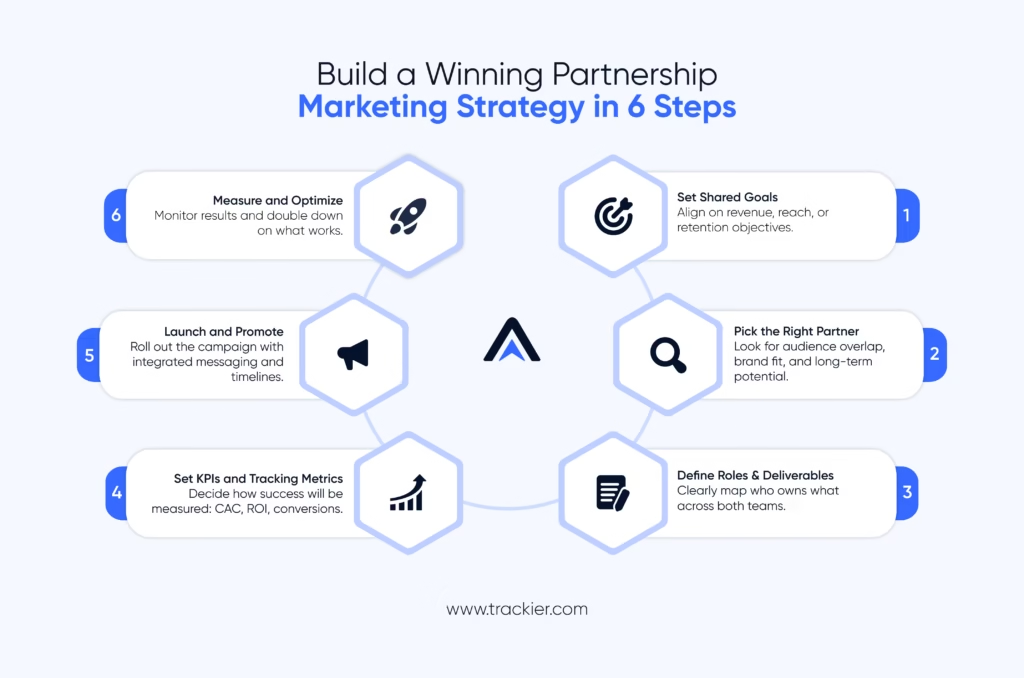
What Are the Best Examples of Partnership Marketing Strategy Done Right?
The real secret behind a successful partnership marketing strategy lies in learning from brands that have made it work.
Here are four standout partnership marketing strategy examples that made it big.
1. HubSpot + LinkedIn
HubSpot’s integration with LinkedIn Ads lets marketers create and manage campaigns directly within HubSpot, removing tedious platform switching.
- Performance: One report notes a 98% increase in ROAS and 500 hours of manual work saved each month after enabling the integration.
- Why it succeeded: It solves real workflow friction and boosts efficiency for marketing and sales teams, making campaign management faster and more effective.
2. Shopify + TikTok
Shopify partnered with TikTok to bring in‑stream shopping to social videos, enabling merchants to tag and sell products directly through TikTok content.
- Stat: As of July 2025, around 39% of TikTok users report they purchased something they discovered on the platform.
- Why it works: It taps into spontaneous buying behavior, especially among Gen Z and Gen Alpha audiences, turning discovery into direct sales.
3. Slack + Zoom
Rather than building its own conferencing tool, Slack integrated Zoom so users can launch meetings directly from Slack channels.
- Growth: This integration is now used by over 15,000 Slack teams, growing adoption by approximately 200%.
- Why it succeeded: It bundles essential tools into one seamless experience, reducing friction and increasing user satisfaction.
4. Bumble + Spotify
Bumble added Spotify integrations, allowing users to display ‘Top Artists’ in their dating profiles, a clever way to spark conversations.
- Why it stood out: Music preference became an authentic icebreaker, leading to noticeably more meaningful connections on the app.
- Why it worked: It uses cultural identity cues and turns profile browsing into engaging interaction.
What Makes These Examples Stand-Out?
These success stories share several common elements:
- Genuine value creation: Each partnership delivers direct benefits, whether that’s saving time, boosting sales, or improving user experience.
- Audience alignment: These collaborations connect brands whose users naturally overlap, common examples include B2B teams, shoppers, daters, etc.
- Seamless execution: The partnerships are embedded into product experiences, not just slotted as separate campaigns.
- Measured outcomes: Whether it’s ROAS, adoption, or engagement, every result was tracked with clear metrics.
Why Do Some Marketing Partnerships Fail to Deliver Results?
Let’s be honest. Not every partnership turns into an out-of-the-world, viral collaboration.
For every Spotify – Bumble or Slack – Zoom success story, there are dozens of mismatched, mismanaged, or just plain meh collaborations that fizzle out quietly.
So, what really goes wrong?
Below are the biggest reasons why even the most promising marketing partnerships can fall flat:
1. Mismatched Brand Values
Think of partnerships like relationships. If your partner’s brand tone screams hustle and grind, and yours leans more sustainability and mindfulness, you’re already speaking two different languages.
This mismatch makes your messaging confusing, and worst case, it makes your audience question your credibility.
Partnerships thrive when there’s alignment in brand ethos, not just reach.
2. No Audience Overlap
You could team up with the biggest name in your industry. But if their audience doesn’t care about what you sell, it’s not marketing but useless noise.
Take time to analyze not just follower count or market size, but shared buyer intent.
If your partner’s audience wouldn’t naturally benefit from your offering, engagement will be surface-level at best.
3. Vague Collaboration Goals
If both teams go into the partnership saying “Let’s just see what happens,” they’ll likely come out with… not much.
Successful partnerships need structure.
Are you aiming for leads, signups, installs, sales? Who’s handling what? What does success look like at the end of 30 days, 90 days, or a year?
Lack of alignment on goals is the silent killer of results.
4. One-Sided Value Exchange
If one party does all the heavy lifting, say managing logistics, creating assets, and handling promotions, it is very easy for resentment to build. Even worse? It shows.
Partnerships work best when each brand brings a unique strength to the table. That could be audience size, technical capability, creative firepower, or budget. But the balance has to feel fair.
5. Weak Tracking and Attribution
Even if a campaign performs decently, if you’re not tracking the right KPIs, or can’t attribute results back to your partner, you’ll never know if it was worth it.
That’s why tools like Trackier’s Marketing Analytics exist: to help brands assign value clearly, track conversions accurately, and automate payouts when needed.
6. Lack of Execution Ownership
It’s easy to say “We’ll co-promote the campaign,” but without clear owners, things slip through the cracks.
Maybe the social posts go live late. Maybe no one followed up on leads. Maybe your partner’s team was “busy with other things.”
Execution kills more great strategies than bad planning ever will.
How to Pick the Right Partner
Picking the right partner is all about who fits right.
Because in a partnership marketing strategy, compatibility is everything. After all, you’re trusting someone else with your audience.
So how do you make sure you’re choosing a partner who can actually help you chase those metrics?
Here’s a quick checklist:
Check for Audience Overlap
If your audiences wouldn’t sit at the same dinner table, they probably won’t click on the same CTA. Look for partners whose followers, customers, or community members share similar interests, problems, or purchase behavior with yours.
Always ask:
- Do they serve the same industry vertical?
- Do they target similar buyer personas?
- Would their users find your product naturally useful?
If the answer is yes across the board, you’re off to a strong start.
Align on Brand Values and Messaging
You don’t need to be twins, but you can’t be polar opposites either. Make sure your partner’s tone, mission, and reputation won’t clash with yours.
Pro Tip: Go through their last 10 blog posts or campaign headlines. Does the voice feel complementary to yours? If you’re thoughtful and research-heavy, and they’re all hype and slang, there’s going to be tension.
Review Their Track Record
Past behavior is the best predictor of future behavior. If they’ve nailed co-marketing campaigns in the past, that’s a green flag. But if you see spotty execution, low engagement, or ghosted collaborations, it’s time to walk away.
Look for:
- Case studies or campaign results
- Existing integrations or successful partner programs
- Testimonials from previous collaborators
Map Complementary Strengths
Great partnerships are all about about filling in each other’s gaps.
Here’s an example:
- Your team is strong on content, but their team has a massive email list.
- You’ve built a great tool, they’ve got a YouTube audience ready to test it live.
When both sides bring something unique to the table, magic happens.
Discuss Attribution Before Anything Else
Don’t wait until after the campaign launches to figure out how to track success.
Clarify from Day 0:
- Who gets credit for what?
- What tools will you use to track leads or conversions?
- How will payouts or incentives work?
This is where platforms like Trackier save time, save face, and save the relationship. You can onboard, manage, and reward partners all in one dashboard.
Define Roles, Deadlines, and KPIs Upfront
Ambiguity kills momentum.
So before you even brainstorm creative ideas, get clear on:
- Who’s writing copy?
- Who’s designing creatives?
- When does the promo start?
- What are the expected outcomes?
Even the best partner can underdeliver if they’re not sure what “delivering” means.
Bonus Tip: Run a Mini Campaign First
Not ready to commit? Test the waters with a one-off content collaboration or social cross-promotion. Treat it like a dress rehearsal. If the vibes are good and the results track, you’ve found your person.
Choosing the right partner is resource optimization. When your partnership marketing strategy starts with alignment and not assumption, you’ll spend less time putting out fires and more time scaling what works.
What Does Trackier Do For a Smarter Partnership Marketing Strategy?
You’ve picked the right partner. You’ve aligned on goals. You’ve even set a launch date. But without the right tech stack holding it all together, your entire partnership marketing strategy can fall apart fast.
Because let’s face it, managing partnerships manually slows you down, it’s messy, and you’ll feel the pain later.
Here’s how the right support makes your partnership marketing strategy smoother, smarter, and actually scalable.
1. Automated Tracking and Attribution
Suppose your campaign goes live. Conversions start trickling in. But… who gets credit for what?
Without clear attribution, partner trust erodes fast. Technology platforms like affiliate tracking tools help you:
- Assign conversions to the correct partner in real-time
- Attribute signups, sales, or actions to specific campaigns
- Prevent double-counting or missed conversions
This is not optional. It’s the backbone of performance-based partner marketing.
2. Custom Dashboards for Partners
Your partners need to see how they’re doing. And they shouldn’t have to Slack you every time they want a number.
With modern partner platforms, you can:
- Give each partner a branded dashboard
- Show real-time clicks, conversions, and earnings
- Make reporting self-serve and transparent
This kind of visibility keeps partners motivated to perform better.
3. Payout Automation and Incentives
Manually calculating payouts every month is a recipe for delays and mistakes. Worse, it signals to your partners that you’re not serious about their contribution.
Tech makes this simple:
- Set payout rules in advance
- Automate monthly or performance-based payments
- Offer tiered bonuses based on custom KPIs
This keeps your program efficient and your partners loyal.
4. Fraud Prevention Tools
Not all traffic is good traffic. Click fraud, fake signups, and bot installs can bleed your budget if you’re not watching closely.
The best partner marketing software uses built-in fraud detection to:
- Block invalid clicks at the source
- Flag suspicious partner behavior
- Protect your ROAS from being inflated by junk traffic
If you’re not using this kind of protection, you’re probably paying for more than you’re getting.
5. Unified Campaign Management
A single workspace where you could launch, track, analyze, and scale every partner campaign, without falling down a rabbit hole of spreadsheets.
That’s what smart tech offers. The ability to:
- Create campaigns in minutes
- Set rules by partner type or geography
- Track performance across channels in one place
No more chaos. Just clean execution.
So, Does Tech Replace the Human Element?
Not at all.
Your team still builds the relationship, aligns on strategy, and drives the creative vision. But the right technology gives you scale. It gives your partners a better experience. And it gives you the data you need to prove that partner marketing is more than just luck, it takes actual work.
And well, count your lucky stars, because Trackier is designed exactly for that.
Don’t be shy, see it in action NOW!
Still figuring out what we’re made of? Check out our case studies to see why other marketers are absolutely loving Trackier.
Wrapping Up
Building a strong partnership marketing strategy really revolves around building long-term, scalable systems that let you build unshakable trust, share audiences, and drive performance without overpaying for clicks.
Whether you’re teaming up with affiliates, launching a co-branded campaign, or syncing up tech stacks across ecosystems, the key lies in alignment. The right partners, the right goals, and the right tools can unlock serious growth.
Here’s what we covered:
- Why partnership marketing is booming in 2025
- How it actually works under the hood
- The 8 types of marketing partnerships that drive results
- A step-by-step blueprint to build your own strategy
- Real-world examples that prove it works
- And the tech (like Trackier) that brings it all together
Audit your existing efforts. Look for white spaces where a partner could fill the gap. And if you want a smarter way to track, manage, and optimize every campaign in real time, Trackier is built for marketers like you.
Hungry for more?
Sign up for our weekly newsletter to get tips like these delivered, straight to your feed.
Subscribe on LinkedInFAQs
1. What are the different types of marketing partnerships?
Marketing partnerships come in many forms, each tailored to different goals and audiences. The most common types include:
- Affiliate partnerships where partners earn commission on conversions
- Co-branding campaigns that boost mutual brand equity
- Technology integrations for SaaS platforms looking to create deeper value
- Content collaborations like whitepapers, webinars, and blogs
- Channel partnerships involving resellers or distributors
- Sponsorships for events, podcasts, or content series
- Influencer and ambassador tie-ups that create trust and long-term engagement
- Joint product launches for deeper, more strategic collaboration
Each type serves a specific function in a broader partnership marketing strategy, and some brands combine several to maximize reach and ROI.
2. What is a partner marketing strategy exactly?
A partner marketing strategy is a structured approach to collaborating with other businesses, creators, or platforms to achieve shared goals, like expanding reach, increasing sales, or building brand trust. Instead of going it alone, you build campaigns where both parties contribute value and drive results.
Done right, partner marketing becomes more than just a tactic. It turns into a revenue engine supported by aligned interests, shared audiences, and measurable outcomes.
3. What are the main objectives of partner marketing?
The objectives can vary by brand and campaign, but a partner marketing strategy aims at:
- Expand reach into new but relevant audiences
- Increase conversions through trusted partner channels
- Boost credibility by association with established brands or thought leaders
- Reduce CAC by leveraging shared promotion instead of costly ads
- Generate revenue through performance-based models like affiliate marketing
In short, the goal is sustainable, trackable growth, with less reliance on paid ads and more emphasis on relationship-driven success.
